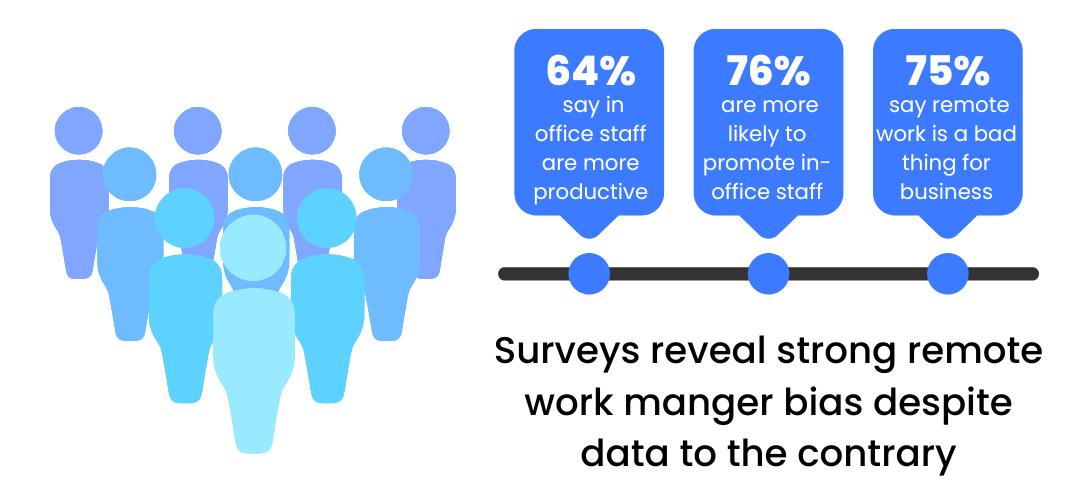Today, winning the office battle has to focus on productivity, engagement, and results. The good news is that there are many things you can do to make your hybrid office work. In this post, we will review four most common barriers to designing and implementing a successful hybrid office and how to fix them.
1. Resistance From Management
Management resistance is one of your biggest challenges when implementing a hybrid workplace. The mere suggestion of changing work practices at an organization can be met with all kinds of pushback from the top down. This can be particularly true if a change involves altering the status quo or disrupting the existing power structure.
Management buy-in is key to a successful implementation and should not be taken lightly! Without their support, it can be difficult, if not impossible, to enact a successful plan, as they may have conflicting views on the issues.

https://www.transformativeworkdesign.com
Management bias can lead to poor decision-making. For example, Research by the Centre for Transformative Work Design found that managers are dramatically more likely to say employees who work on-site are higher performers (64% saying this). And they are more likely to promote people who come into the office (76%). But the data shows that off-site workers are just as productive, if not more so.
In fact, in one study of 700 employees and managers, 75% of managers said that remote work was a bad thing for their organization—despite the fact that it has been proven to increase employee performance by up to 50%. It’s not surprising that managers are more likely to view on-site work as a positive thing. It means they can see their employees' actions and know when they’re slacking off. But it also means they can micromanage them better. Management bias can lead to poor decision-making because it doesn't take into account the needs of the people being managed.
How to identify remote bias in the workplace:
- Take a step back and consider your assumptions.
- Ask yourself, “What are the benefits of remote work?”
- Consider whether there are ways to enable remote work without sacrificing employee productivity.
2. Poor Collaboration
Collaboration failure is one of the biggest pitfalls in a hybrid office. When you're in the office, everyone has a chance to be part of a team and share ideas and knowledge. But when some are working from home, and others are in the office, it's easy for people to feel isolated and unable to contribute.
Three tips to help your teams collaborate effectively:
- Create a digital space that's accessible to everyone. This can be as simple as creating a shared drive on your company's network or more complicated if you have people working from home who need to access the same information.
- Schedule regular online meetings. If possible, try to do these once per week so that everyone has an opportunity to share what they're working on and get feedback from other team members.
- Be sure to have meetings over video chat so that everyone can participate. Zoom fatigue is real, so make sure meetings stay focused. Make a habit of using reactions on the video platform to get people more involved and engaged during the meeting. This will help create a sense of togetherness and collaboration even when people are working remotely.
3. Lost Team Morale And Connection
If your office space is impersonal or uninspired, the team morale can take a hit. Employees might be unhappy with the office environment and feel like they're working in a cubicle instead of collaborating on important projects. The lack of team bonding leads to less effective communication, which results in lost productivity overall.
People will be less likely to collaborate with each other when they don't spend time together at work because there aren't any shared spaces for interaction during the day. And if you have an open floor plan that's too large for its own good, then there's no way for people who sit far away from each other—and may not even know each other personally—to break down those barriers and become familiarized with one another as coworkers rather than just "fellow occupants" of an office building."

The number one reason employees want to work in the office is collaboration and social connection. It's important to ensure that your space supports that.
How to Improve Office Team Bonding:
- Create an office space that’s comfortable and inviting. This will help people feel more relaxed at work and enable them to focus on getting their jobs done.
- Include an area where employees can get together to collaborate and bond. This could be a lounge, break room, or even just a shared workspace that’s not being used at the time.
- Emphasize the importance of having fun at work. This can be done by creating a culture where team bonding is encouraged, whether that means planning events such as lunches or office parties, or simply making it clear that you want everyone to get along well and enjoy each other's company.
4. Technology Barriers
In a hybrid office environment, technology is the bridge that connects your remote employees to their colleagues in the office. It's important to understand what kind of technology will best serve your hybrid team, and how to implement it so everyone can easily access and use it.

Many employees are struggling at the moment with too many tools and impacting too little of their ability to be productive. Look for tools that integrate all your various resources to make them easier for employees to access, personalize and use to make the most of their work time.
It's important to understand how technology can affect the work-life balance of your remote employees. In order to keep them happy and productive, provide them with the tools they need to stay connected while maintaining their personal lives outside of work.
Conclusion
We’re quickly moving away from the traditional office and towards a more open environment where people can work anywhere. But it takes a lot of planning to make that transition smooth and successful. We’ve seen some successes, but also many failures—and we hope that this article has helped you avoid making those same mistakes.



